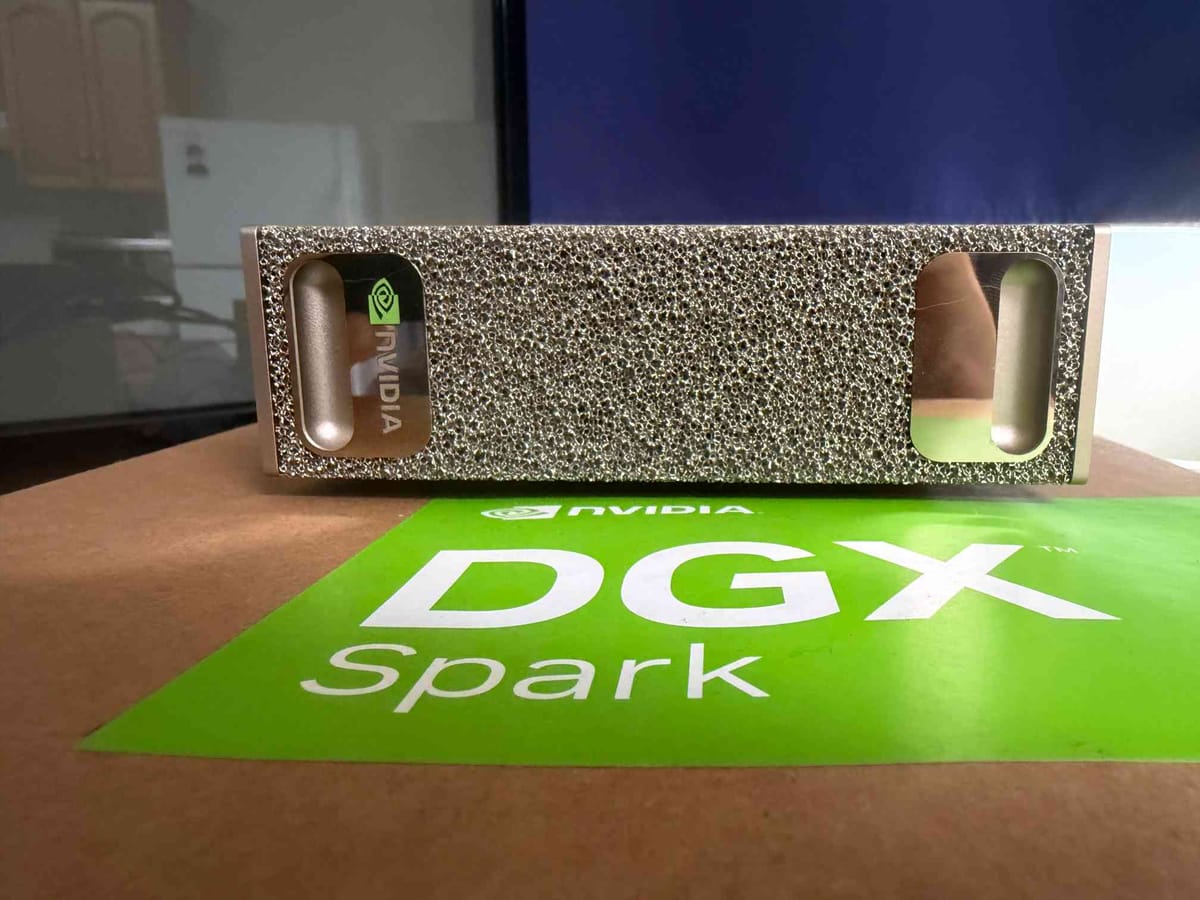NVIDIA DGX Spark: Powerful Hardware, Early-Stage Ecosystem

First Impressions: NVIDIA DGX Spark Preview
14 October 2025
NVIDIA sent me a preview unit of their new DGX Spark — a desktop “AI supercomputer”.
This is my first-ever hardware review, and while you could call it a sponsored post (because they sent me the unit), there was:
- No cash payment.
- No editorial control requested or allowed.
- Only an embargo date to follow.
The Spark will retail for around $4,000, with official sales starting tomorrow.
---
Design & Build
This is a sleek and compact little computer — roughly the size of a Mac mini, with a textured surface that feels fresh and slightly science fiction-like.

---
Hardware Specs
Extracted via Claude Code:
Architecture: ARM64 (`aarch64`)
CPU: 20 cores
- 10× Cortex-X925 (performance)
- 10× Cortex-A725 (efficiency)
RAM:
- 119 GB total (112 GB available)
- Claude’s report differs from official 128 GB spec
Storage: 3.7 TB NVMe SSD (3.3 TB free)
GPU (NVIDIA GB10, Blackwell architecture):
- Compute Capability `sm_121 (12.1)`
- 119.68 GB GPU memory
- 48 streaming multiprocessors
> Summary: ARM64 architecture, 128 GB shared memory between GPU & CPU, plus 4 TB NVMe SSD storage.
---
Target Audience
The Spark feels like a consumer-friendly gateway to AI computing power typically found only in datacenters.
Ideal for:
- AI researchers
- Developers
- Advanced creators working on model training and inference locally
---
CUDA on ARM64 — The Learning Curve
On my Mac, model experiments got easier over the last 18 months thanks to MLX, but CUDA support was missing. Many AI libraries assume NVIDIA GPUs and x86 architecture.
Now with Spark + NVIDIA GPU, I hit a new limitation: much software assumes x86, not ARM64.
Example struggles:
- Found PyTorch 2.7 wheel for CUDA on ARM — but no 2.8 equivalent.
- ARM CUDA ecosystem is still young and confusing.
---
NVIDIA’s Solution: Official Docker Support
Finding NVIDIA’s DGX Spark Docker guide made life easier.
Working command example:
# Your Docker run command hereAnd for full GPU access:
docker run -it --gpus=all \
-v /usr/local/cuda:/usr/local/cuda:ro \
nvcr.io/nvidia/cuda:13.0.1-devel-ubuntu24.04 \
bash---
CUDA 12 vs CUDA 13
Still figuring out the differences:
- CUDA 13 is very new.
- Most existing docs and examples target CUDA 12.
- This mismatch requires careful library version checks.
---
Improved Documentation
When I first got Spark, NVIDIA’s docs were sparse. A month later:
- New Getting Started guide
- Set of playbooks
- These are exactly what early adopters need.
---
Claude Code Was Essential
Claude Code helped me:
- Refresh rusty Ubuntu skills
- Install and configure CUDA drivers
- Run PyTorch inside Docker with GPU support
I went full “YOLO mode” since tests were disposable containers.
---
Installing Claude in Docker Safely
Claude won’t allow `--dangerously-skip-permissions` as root.
Steps:
- Create a non-root user in `nvcr.io/nvidia/cuda:13.0.1-devel-ubuntu24.04`
- Install Claude Code under that user
apt-get update && apt-get install -y sudo
# Find first UID >=1000
U=$(for i in $(seq 1000 65000); do if ! getent passwd $i >/dev/null; then echo $i; break; fi; done)
echo "Chosen UID: $U"
# Same for GID
G=$(for i in $(seq 1000 65000); do if ! getent group $i >/dev/null; then echo $i; break; fi; done)
echo "Chosen GID: $G"
groupadd -g "$G" devgrp
useradd -m -u "$U" -g "$G" -s /bin/bash dev
printf 'dev ALL=(ALL) NOPASSWD:ALL\n' > /etc/sudoers.d/90-dev-nopasswd
chmod 0440 /etc/sudoers.d/90-dev-nopasswd
DEBIAN_FRONTEND=noninteractive TZ=Etc/UTC apt-get install -y npm
npm install -g @anthropic-ai/claude-codeThen:
su - dev
claude --dangerously-skip-permissions---
Running `llama.cpp` with GPU
Goal: run Qwen3-4B-GGUF via `llama.cpp`:
llama-cli -hf unsloth/Qwen3-4B-GGUF -p "I believe the meaning of life is" -n 128 -no-cnvClaude explored, compiled, and configured `llama.cpp` until it worked perfectly with GPU acceleration.
---
Remote Access: Tailscale FTW
Installed Tailscale on Spark via Ubuntu instructions, logged in via Google SSO → device instantly visible across laptop and phone.
For remote SSH:
- Termius iOS
- Plus mobile-friendly LLM UIs like Open WebUI
---
Ecosystem Momentum
Embargo lifted → community projects lit up:
- Ollama ready at launch
- llama.cpp benchmarks on Spark — impressive performance
- LM Studio build for Spark
- Official vLLM container
---
Conclusion — Should You Get One?
Too early for a firm verdict, but:
- CUDA + ARM64 learning curve still steep
- Rapid ecosystem progress in last 24h suggests better support soon
For creators and researchers, pairing Spark with open-source AI content publishing frameworks like AiToEarn could be powerful:
- Multi-platform publishing
- Analytics & AI model ranking
- Monetization hooks
---
Would you like me to also produce a condensed quick-start guide section so readers can set up CUDA, Docker, and `llama.cpp` on Spark in under 15 minutes?


